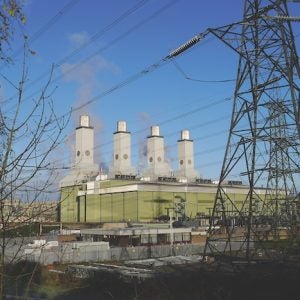The intermittency and variable nature of solar and wind power presents a growing challenge for power networks. Renewable energy is playing an increasingly important role in the energy mix, but such sources lack the capability to tolerate network faults or play a grid support role. As a result, the increasing penetration of these sources of power in the energy mix is reducing the resilience and stability of electricity networks.
One example of this challenge is the medium- to large-scale solar farms that use inverters to convert the DC voltage produced by solar panels to the alternating voltage required for the local power network. A fault occurring somewhere in the network can cause the inverter’s protection equipment to take it offline. The result is that the solar farm has no capability to ride through network faults.
A further effect of the increased use of renewables is that many conventional power plants are being decommissioned. That means there are fewer sites with the large rotating generating equipment that grids have relied on for the short-circuit power and inertia to maintain their stable operation. In this type of situation, an old technology, using synchronous condensers, can provide additional short-circuit power to strengthen the grid, help to maintain grid quality, and provide fault ride-through capability.
All large grids with RE sources will in due course be compelled to deal with this problem. A useful object lesson and guide to the future is provided by the Australian grid system, which is taking in solar and wind energy sources at an impressive rate. A report published in September 2018 by the Australian National University’s Energy Change Institute indicated that the country’s renewable energy industry will install more than 10 GW of new solar and wind power by the end of 2019. If that rate is maintained, Australia will reach 50 % renewables in 2025.
Solutions
ElectraNet is the electricity transmission company in South Australia. It operates 5591 km of high-voltage transmission lines. In February 2019 it produced a report – “Addressing the system strength gap in SA, economic Evaluation Report” – which sought to indicate the way forward for the South Australia grid.
It studied what it considered to be the two viable solutions capable of dealing with the increasing risk of grid instability, namely the awarding of suitable contracts to the operators of gas fired conventional generation, and the deployment of synchronous condensers at strategic points in the network.
Its main conclusions were:
- Contracts with existing gas-fired generators would not be an economically viable solution based on the market costs of this option.
- Installing synchronous condensers on the transmission network is the most efficient and least cost solution in the short to medium term.
- The costs of the current generator direction process continue to grow, reinforcing the need for installation of synchronous condensers as soon as possible, which will bring forward generator direction cost savings for customers.
- Installing synchronous condensers remains a no-regrets measure to meet the minimum need for system strength in the absence of any other available solutions in the immediate term, noting that any future sources of system strength that emerge will help address wider constraints on the power system.
- This system strength solution is also expected to efficiently meet the minimum threshold level of inertia in South Australia through the installation of high inertia machines, at minimal additional cost.
Synchronous condensers
SCs are rotating electrical machines that closely resemble synchronous generators. However, they are not generators, as they are not driven by an engine or turbine. Nor are they motors, as they do not drive a load.
A growing number of network operators and renewable energy developers, are now turning to synchronous condensers to provide additional short-circuit power to strengthen their grid. SCs also help maintain power quality and provide fault ride-through capability.
How they work
Synchronous condensers such as those manufactured by ABB (Figure 1) feature a brushless or static excitation system that allows for considerable over-excitation (field forcing) to cope with network contingencies. Excitation control is provided by an automatic voltage regulator (AVR) which is tuned to match the requirements of the specific application.
Grid stabilisation
In the past SCs have been used as sources of reactive power to compensate for induction motors and other highly inductive loads. Advances in power electronics led to the development of static compensators and these replaced SCs as they offered better controllability, flexibility and speed. Demand for SCs slumped and for many years they looked like an obsolete technology. But because they produce reactive power synchroous condensers are now seen as a useful solution for stabilising the power produced by renewable resources.
SCs can also be used to strengthen the short-circuit capacity of networks that are subject to seasonal variations in power demand or major fluctuations due to local heavy industry. In addition, they can be used to produce reactive power locally in order to minimise losses in grids where power production and consumption are separated by long distances.
Because system performance requirements and site conditions vary so much, SCs need to be tailored for their specific application. ABB supplies SCs in the power range 1 – 75 MVA at 3 – 15 kV system voltage.
The network voltage is generally much higher, so a step-up transformer is used. The SCs are modular, and several can be combined for higher outputs – a solution that also provides better redundancy and availability than a single large unit.






